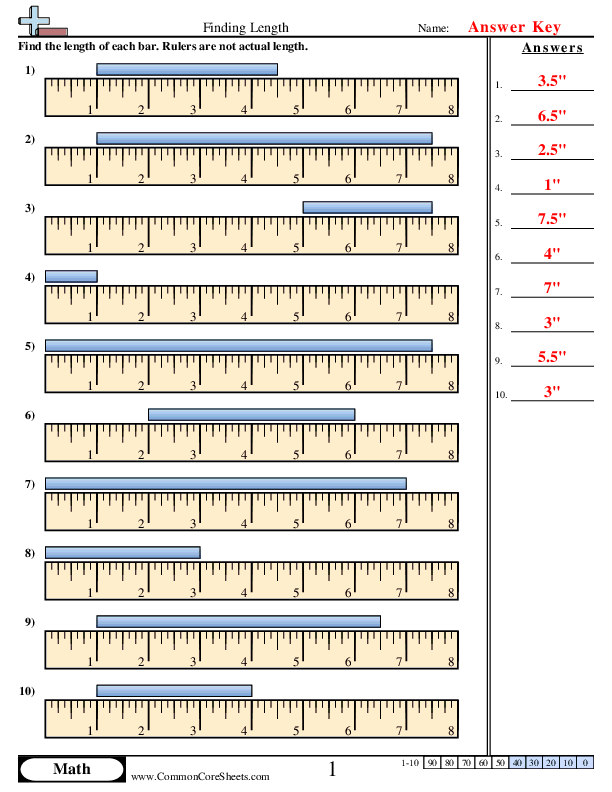Looking for the best measurement worksheets on the internet? Look no further! Our measurement worksheets are designed to help students of all ages learn and practice the important skill of measurement. From length and weight to volume and capacity, our worksheets cover a wide range of topics to ensure a well-rounded understanding of measurement concepts. And the best part? They're all free! Simply download and print as many copies as you need for your classroom or home use. These measurement worksheets are a great resource for teachers, students, and parents looking to improve their measurement skills. Try them out today and see the difference they can make in your understanding of measurement.
Browse Sheets By Problem Type
×
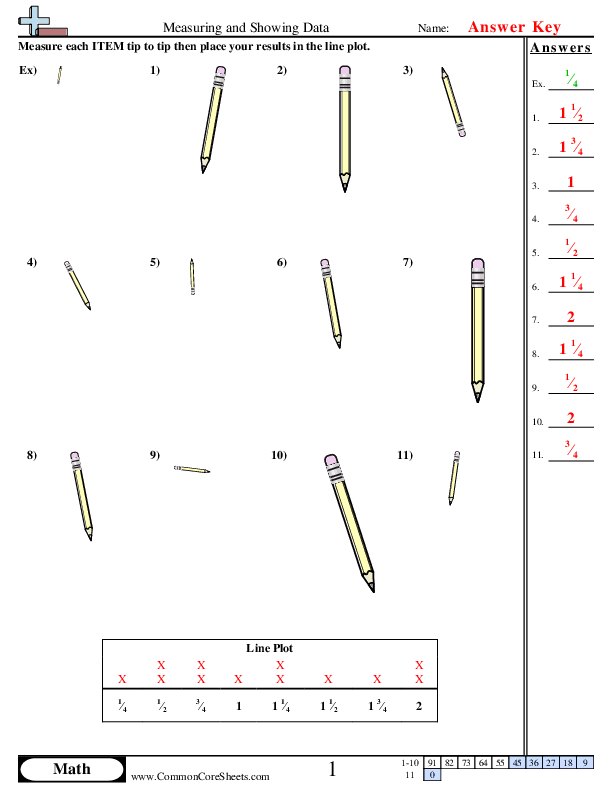
Measuring and Showing Data
3md4


×
Description:
"This worksheet is designed to empower children's understanding of math, specifically in the area of data measurement. Containing 11 stimulating math problems, it provides engaging challenges on displaying and interpreting data. The worksheet enables customization, and can be converted into flashcards for more interactive learning. It's also an ideal resource for distance learning endeavours to ensure continuous learning despite being away from a traditional classroom setup."

×
Student Goals:
Data Interpretation SkillsUpon completion of the worksheet, students should have developed advanced data interpretation skills. They will be proficient in understanding various data forms, including graphs, tables, and charts. Their comprehension of the underlying statistical concepts should enhance, enabling them to critically analyze presented data.Measurement UnderstandingStudents will gain an understanding of how to execute precise measurements and accurately record data. Grasping fundamental principles of measurements, students will be able to identify appropriate units and tools for measurement in practical situations.Problem-Solving AbilitiesThe worksheet is designed to sharpen students' problem-solving abilities. By tackling various problems, they will be well-positioned to develop systematic approaches to breaking down complex issues and devise effective solutions.Data Representation TechniquesAfter completing the worksheet, students should excel in data representation. They will be capable of using various methods to visually present data. Such skills are vital in communicating information in a succinct, understandable manner.Improved Mathematical LiteracyThe comprehensive structure of the worksheet will ensure an improvement in students' mathematical literacy. By becoming versed in data measurement and representation, they will broaden their understanding of mathematical concepts and language.Enhanced Critical ThinkingCompleting the worksheet will hone students' critical thinking skills. The ability to make logical connections between different pieces of information will be enhanced. This invaluable skill will prove useful across other academic subjects and in daily life situations.Quantitative ReasoningStudents will develop quantitative reasoning skills, enabling them to interpret numerical data accurately, draw appropriate conclusions, and make forecasts. They will gain knowledge about the importance and practices of accurate data prediction in decision-making processes.


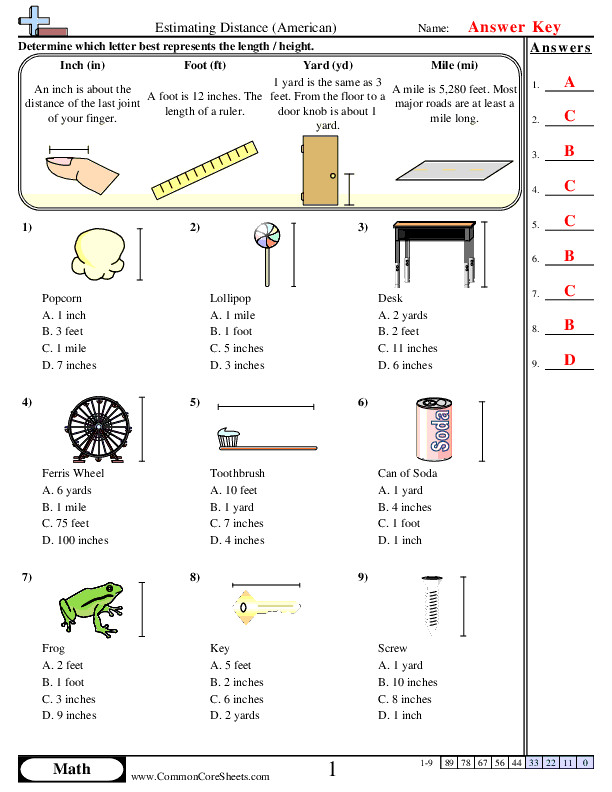
Estimating Length (American)
4md1


×
Description:
"This worksheet is designed to improve children's estimation of distances in a fun and interactive manner. Covering a wide range of objects, from skateboards to frogs, the activities engage learners through nine diverse math problems. Customizable to different learning needs, this worksheet can be converted into flash cards or suitably adapted for distance learning, ensuring flexibility in teaching methods while solidifying essential mathematical concepts."

×
Student Goals:
Understanding of MeasurementsUpon completion of the 'Estimating Distance' worksheet, students should have a developed understanding of the various units of measurement used in the American system. These include inches, feet, yards, and miles, and students will become familiar with their relative lengths and everyday uses.Estimation SkillsThe worksheet is designed to improve the practical estimation skills of students. Faced with objects and distances of various sizes, students should learn how to make quick yet accurate approximate evaluations of distances and sizes using known benchmarks. Thus, sharpening their mental estimation skills.Real-World ApplicationsAfter completing this worksheet, learners should have a clearer understanding of how these units of measurement are applied in real-world contexts. By relating commonly known objects in their estimation exercises, students gain insights into real-world applications of measurements.Critical ThinkingStudents will also enhance their critical thinking skills through the course of completing the worksheet. With every problem, students are required to consider the size and scale of the objects and distances involved, and to select the most appropriate unit of measurement. This encourages concept analysis and strategic thinking.Confidence BuildingFinally, successfully completing the worksheet should boost the students' confidence in their mathematical abilities. Not only will they have a stronger grasp of American measurement units, but they will also have refined their estimation and reasoning abilities. This increased confidence can inspire a more positive attitude towards learning math and related subjects.


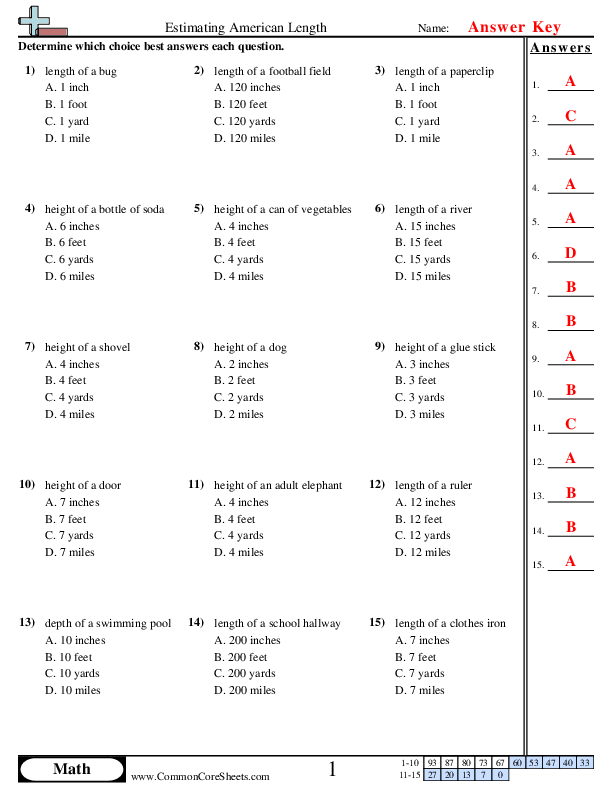
Determining Appropriate Measurement (American)
4md1


×
Description:
"This worksheet is designed to teach math through the concept of estimating American lengths. From social objects to natural wonders, the tasks encourage children to familiarize themselves with measurements like inches, feet, yards, and miles. It features 15 problems and can be easily customized, converted into flashcards, or used for distance learning, making it versatile for various teaching methods and environments."

×
Student Goals:
Measurement UnderstandingUpon successful completion of this worksheet, students will develop a solid understanding of the American length measurement units including inches, feet, yards, and miles, and the relative differences between them. They will gain insight into making educated estimations on the lengths and heights of everyday objects and elements of the natural world.Estimation SkillsStudents will develop valuable estimation skills which are critical not only in the subject of math, but throughout various aspects of life. They will become comfortable with making an educated guess or estimate, which can be a valuable problem-solving tool when precise information is unavailable.Real-World ApplicationsThe completion of this worksheet will enable students to apply their learning into real-world contexts. By relating the problems to everyday items like a can of soda or a skateboard, they will be able to visualize and grasp the concept of length estimation better. This understanding will transfer to their ability to approximate and compare distances in real-life situations.Critical ThinkingThis worksheet fosters critical thinking by encouraging students to use their knowledge of measurement units to evaluate and choose the most reasonable answer out of multiple choices. This skill of critically evaluating multiple potential solutions will benefit them in future mathematical problems as well as in wider life situations.Builds ConfidenceBy systematically developing an understanding and honing their estimation skills, students will gain confidence in handling problems related to length measurement. They will become capable of making quick estimations in their head and develop a sense of achievement in their mathematical abilities.Promotes Active LearningFinally, since the learning is couched within the framework of practical, real-life objects and situations, students are motivated to actively engage with the content. This active involvement in their own learning process can lead to a deeper understanding of the subject and improved academic performance in the long run.



Converting American Lengths
5md1


×
Description:
"This worksheet is designed to aid children in converting American lengths for math learning. It features 20 problems, including conversion of feet to inches, yards to feet, fostering practical calculation skills. Ideal for distance learning, it can be customized to fit individual needs, or converted into flashcards for an interactive experience."

×
Student Goals:
Measurement Conversion UnderstandingAfter successful completion of this worksheet, students will have a clear understanding of how to convert American length units. They will be perfectly equipped to effortlessly interchange between feet, inches, and yards, fundamental building blocks of the American measurement system.Problem Solving SkillsThe variety of problems presented in the worksheet will help students to enhance their problem-solving skills. They will be better at tackling conversion problems, irrespective of the units of length involved, thus strengthening their capability to resolve real-world mathematical problems.Application of Mathematical KnowledgeThis worksheet will enable students to apply their theoretical knowledge of the American measurement system into practical examples. They will be adept at using their mathematical knowledge in everyday situations, be it understanding their height, or estimating the length of objects.Mental Math AgilityPractice makes perfect. Completing this worksheet will improve the student’s mental math agility. The continuous practice of conversion formulas not only fosters their memory recall but also accelerates their mental math speed, an essential skill for further mathematical learning.Boost ConfidenceAs students progress through the worksheet and start getting the correct answers, they will develop confidence in their mathematical abilities. This boost in self-esteem can encourage them to take on more complex mathematical challenges in the future.Foundation for Advanced LearningMastering unit conversion is a foundational requirement for advanced mathematical concepts and scientific calculations, in physics and engineering for example. Hence, successfully completing this worksheet lays the groundwork for students' future learning journey in these areas.


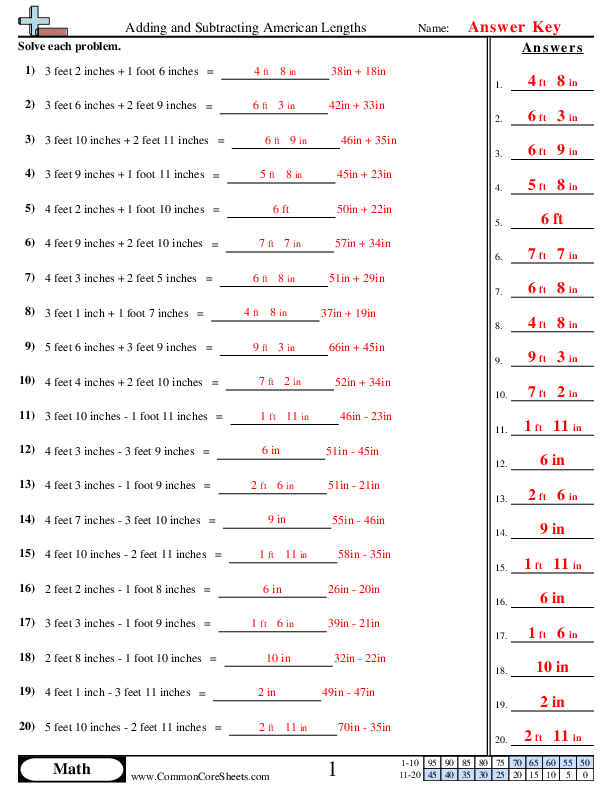
Adding and Subtracting American Lengths


×
Description:
"This worksheet is designed to enhance math skills through the practical application of adding and subtracting American lengths. Consisting of 20 problems, children can engage in converting feet and inches, practicing essential arithmetic operations. Ideal for distance learning, the worksheet is seamlessly transformable into customizable flash cards for varied forms of study and reinforcement of concepts."

×
Student Goals:
Understanding of Length MeasurementsAfter completing the worksheet, students should have gained a strong understanding of how American length measurements are used and how to add and subtract them. They will become proficient in conversions between feet and inches and be able to perform operations involving these two units of measurement without difficulty. This foundational understanding of units of length is a crucial aspect of mathematical education, particularly in real-world problem solving.Problem Solving and Arithmetic FluencyThrough the completion of the worksheet, students will have practiced and enhanced their arithmetic skills, and be able to quickly add up the lengths in feet and inches. They will be able to implement these skills to solve more complex problems as their math education progress. Problem-solving is a critical skill that impacts multiple areas of academic and personal life. Strengthening these skills through such practice helps students to approach complex situations logically and efficiently.Improvement of Mathematical VocabularyThe worksheet helps students to get familiar with key terms related to measurement such as feet and inches. They will be able to accurately use these terms in appropriate contexts, which is essential for further learning in math. Through this understanding of mathematical language, students can communicate their mathematical thinking more effectively in written and spoken form.Application of Knowledge to Practical ScenariosThis worksheet provides a fundamental understanding of measurements, which students can apply not just in future math problems, but also in real-life situations. Whether it's measuring for a DIY project or estimating distances, having a clear understanding of American length measurements can be a useful practical skill for students to possess. These practical applications can motivate students to value the mathematics they learn in the classroom and the importance of such skills in everyday life.Enhancement of Cognitive SkillsFinally, working on such worksheets helps develop skills beyond raw mathematical ability. Problem-solving exercises in math cultivate critical thinking, analytical thinking, and logical reasoning abilities. This hones cognitive skills that are not just essential for academics, but for other aspects of life as well. The process of solving each problem increases students' ability to think critically and improve their analysis, decision making and logical reasoning abilities.



Converting Mixed American Lengths


×
Description:
"This worksheet is designed to engage children in converting American lengths, enhancing their knowledge in practical math. Covering 12 problems with varying levels, it guides students to convert between yards, feet, and inches. Ideal for distance learning, the sheet can be customized to meet individual learning styles, and even converted to flash cards for interactive education."

×
Student Goals:
Enhanced Practical Problem-Solving AbilitiesAfter completing the worksheet, students should be able to effectively solve real-world problems involving the conversion of various American length units. They should be able to apply the learned conversion techniques to different mathematical problems in a pragmatic manner.Solid Understanding of American Length UnitsStudents should also have a comprehensive understanding of American length units, including feet, inches, and yards. They should recognize the relationships between these units and how they can be interchangeably used to measure various objects or distances.Increased Mathematical Fluency and PrecisionOne linkage that would be honed after completing this worksheet is fluency and precision in mathematics. The ability to perform unit conversion swiftly and accurately not only promotes computational fluency but also encourages attention to precision.Advanced Decoding and Comprehension SkillsThe worksheet aids in advancing decoding and comprehension skills. The practice problems are structured such that students need to decode the problem's elements and then comprehend the task. By identifying conversion units and computing arithmetic calculations accurately, students reinforce key comprehension skills.Improved Process SkillsThe worksheet is designed to enhance the students' mathematical process skills. This involves recognizing the problem, converting the unit as per the requirement, solving the problem, and reflecting on the solution. Students should be able to develop these steps naturally and systematically over time.Exposure to Mixed Measurement ConversionsThe mixed nature of the problems offered in the worksheet will expose students to a wide range of measurement conversion scenarios. Thus, students should be skilled at converting from one unit to another, whether it is from feet to inches, yards to feet, or any combination of the three.Increased Confidence and Interest in MathematicsFinally, successfully completing this worksheet will boost students' confidence in their math skills, specifically their ability to convert units of measurement. This increased confidence may also spark a greater interest in mathematics more broadly, potentially inspiring students to explore other complex mathematical concepts with renewed curiosity and persistence.


